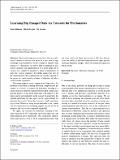Learning Big (Image) Data via Coresets for Dictionaries
Author(s)
Sochen, Nir; Feldman, Dan; Feigin-Almon, Micha
Download10851_2013_Article_431.pdf (1.284Mb)
PUBLISHER_POLICY
Publisher Policy
Article is made available in accordance with the publisher's policy and may be subject to US copyright law. Please refer to the publisher's site for terms of use.
Terms of use
Metadata
Show full item recordAbstract
Signal and image processing have seen an explosion of interest in the last few years in a new form of signal/image characterization via the concept of sparsity with respect to a dictionary. An active field of research is dictionary learning: the representation of a given large set of vectors (e.g. signals or images) as linear combinations of only few vectors (patterns). To further reduce the size of the representation, the combinations are usually required to be sparse, i.e., each signal is a linear combination of only a small number of patterns.
This paper suggests a new computational approach to the problem of dictionary learning, known in computational geometry as coresets. A coreset for dictionary learning is a small smart non-uniform sample from the input signals such that the quality of any given dictionary with respect to the input can be approximated via the coreset. In particular, the optimal dictionary for the input can be approximated by learning the coreset. Since the coreset is small, the learning is faster. Moreover, using merge-and-reduce, the coreset can be constructed for streaming signals that do not fit in memory and can also be computed in parallel.
We apply our coresets for dictionary learning of images using the K-SVD algorithm and bound their size and approximation error analytically. Our simulations demonstrate gain factors of up to 60 in computational time with the same, and even better, performance. We also demonstrate our ability to perform computations on larger patches and high-definition images, where the traditional approach breaks down.
Date issued
2013-03Department
Massachusetts Institute of Technology. Computer Science and Artificial Intelligence Laboratory; Massachusetts Institute of Technology. Media LaboratoryJournal
Journal of Mathematical Imaging and Vision
Publisher
Springer US
Citation
Feldman, Dan, Micha Feigin, and Nir Sochen. “Learning Big (Image) Data via Coresets for Dictionaries.” Journal of Mathematical Imaging and Vision 46, no. 3 (March 20, 2013): 276–291.
Version: Author's final manuscript
ISSN
0924-9907
1573-7683